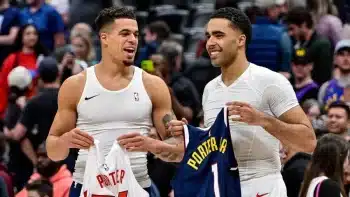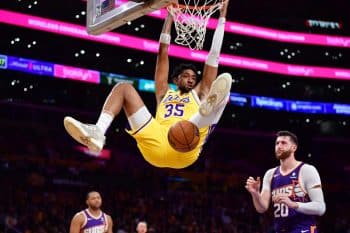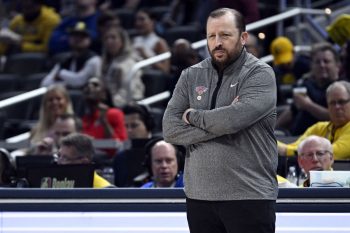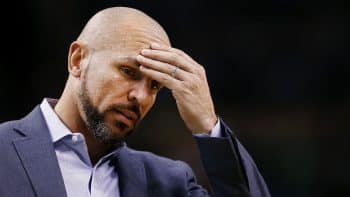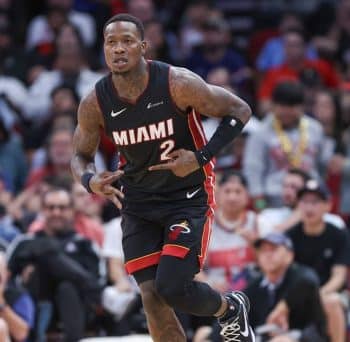NBA
Never Spo Down: On Miami’s Success Without Chris Bosh

It takes gumption to be a successful NBA head coach, and Erik Spoelstra wouldn’t be here without it. At 41 years old and nearly two seasons into a Big Three era that would terrify many grizzled sideline veterans, Spo staked his career and legacy on a new iteration of modern basketball, downsizing his HEAT team in the wake of a Chris Bosh injury and keeping them that way even once Bosh returned. The move in part fueled two straight title runs, along with a league-wide spacing revolution.
With these dilemmas more commonplace a few years later, it’s easy to forget just how huge of a risk this was at the time. Spoelstra was willingly giving up an edge in an area most basketball people were conditioned to associate with success (size down low), banking on the trade-off elsewhere being worth eschewing the traditional approach. That he did it all with the weight of perhaps the most intense scrutiny a team (and star player) had ever faced to that point in history on his back is all the more impressive.
The stakes are lower now; Spo’s success earned him what most would assume is a longer leash from Pat Riley, and with LeBron James back home in Ohio, he can sleep knowing his job isn’t in jeopardy if he can’t win the championship every year. But with a Bosh ailment again taking a big piece off his chessboard, Spoelstra is right back at it. And this time around, without two stars in their prime to pick up the load, his team’s showing might be all the more impressive.
In the East’s fifth spot, but just three games clear of ninth coming out of the break, Bosh’s heart-breaking injury had some people around the NBA believing Miami was no longer a legitimate threat in the East. The HEAT had a point differential more in line with a .500 team than a true contender, and while they’d kept things afloat surprisingly well during non-Bosh minutes while he was healthy, the trickle down to his replacements and primary facets of the team identity was a serious weight to bear.
So naturally, Miami is 10-4 since the news. They have the league’s seventh-ranked offense and its fourth-ranked defense, good for fourth overall on a per-possession basis.
A few bits of lineup creativity are at the heart of the success, one of which came before the Bosh news and has continued to pay dividends since. Amar’e Stoudemire has taken Hassan Whiteside’s place in a small ball starting unit that nearly defies logic with its success; the Goran Dragic-Dwyane Wade-Joe Johnson-Luol Deng-Stoudemire quintet is the best five-man unit in the NBA with at least 75 minutes logged since the break.
Stoudemire may not have a ton left in the tank, but Spoelstra is eking out every last drop. The opening stretches of first and third quarters make up the vast bulk of STAT’s minutes and are often his only appearances in a given game, and he’s only asked to do what he does best – dive to the hoop in pick-and-roll, post up mismatches and utilize all of the space four wings around him generate to do useful things. Even when spacing is imperfect, as it often is with Wade on the floor, three crafty ball-handlers and Stoudemire’s still-present ability to finish without much length around to challenge him has made him a viable roll man again:
Turns out he can still get up over the occasional guy his size, too.
Really, though, it’s the other guys who are flourishing most in these units. Dragic, Deng and Johnson are a combined 51.6 percent from distance in this exact starting lineup since Bosh has been sidelined, per nbawowy.com, a figure that’s at once unsustainable and representative of how open the average look is out there with so much free space available. It’s even more evident near the hoop – Miami is shooting 73 percent within three feet of the basket while these five play together, and lead the NBA in points in the paint as a team since the All-Star break.
How the starters are surviving defensively is anyone’s guess, and whether they can sustain it is a fair question. Deng has been a warrior banging against bigger guys on nearly a nightly basis, but Miami is surviving on pure guile at times. Their speed allows them to close to shooters effectively, and they’ve been worlds better than anyone could have expected at forcing teams to settle for midrange shots, particularly with Stoudemire on the floor. STAT’s lineups are somehow only allowing 60 percent within three feet of the hoop compared to Whiteside’s 57 percent on the season, likely in large part a function of an uber-conservative scheme that drops him way back against two man action and minimizes the damage he can do getting out of position.
The HEAT arguably has an even larger edge when the benches start to trickle in, however. Whiteside would surely be the favorite for Sixth Man of the Year if he’d been in this role since November considering there simply isn’t a second unit in the league adequately prepared to handle him physically.
Miami is second in offensive rebounding percentage since the break despite almost never playing two bigs together, in large part because they collect nearly a third of their own missed shots while Whiteside lays waste to helpless bench units. Rookies Justise Winslow and Josh Richardson have both impressed, the former as a versatile and effective defender and the latter as a sharpshooter canning a ridiculous 63 percent of his triples on over 26 minutes a night since the break. Johnson has been excellent since arriving via buyout as a plug-and-play option who fits Spoelstra’s tinkering style perfectly (he’s logged at least 100 minutes alongside seven different teammates already in just nine games).
Spo knows exactly what he’s got with this group: One high-caliber big man, one true point guard with a capable shot, two situational bigs (Stoudemire and Josh McRoberts) and an abundance of similarly-sized wings with varying skillsets.
Keeping them viable is a tightrope act, particularly to this degree. Dragic is the only player on the entire roster without whom the HEAT have been outscored on a per-possession basis since the break, a remarkable testament to the balance achieved despite a few glaring personnel holes many teams would flounder to account for.
Spoelstra is among the league’s most outside-the-box coaches on defensive assignments, a big part of the team’s success on that end since losing Bosh. In Monday night’s win over Denver, he kept Stoudemire glued to non-shooter Kenneth Faried exclusively (STAT didn’t play a second when Faried wasn’t on the court), alternating Deng and Winslow on the taller, rangier Nikola Jokic. Many coaches balk at a wing defender guarding a talented seven-footer, but Spo is rightfully considering the larger picture – will his team suffer more conceding a few inches of height to Jokic, or by asking a slower Stoudemire to chase a viable floor spacer around the perimeter all night and leave the paint unmanned?
The well might run dry at some point. Spo is asking a lot from guys with plenty of miles on their bodies, and one or two dents to the wing depth at any point could send the whole Jenga stack tumbling. There’s no way guys like Johnson and Richardson can keep burning up nets from deep at this rate, even if they’re mostly shooting open looks. Dragic may have lost a step this year despite functioning well in the scheme, and Wade’s health is never a certainty anymore.
Even if everyone’s whole come playoff time, the specificity of the postseason environment could squeeze out some portion of Spoelstra’s patchwork ingenuity as teams hone in on the weak links in his personnel. Miami has had success minus Bosh, but their ceiling against elite competition only goes so high if he can’t make it back on the court.
Just staying afloat this long would have been an accomplishment, though, and the way the HEAT have continued to churn out wins is a testament to both sides of the coin: Spoelstra’s ingenuity would be useless without player buy-in, and vice versa. An unexpected Bosh return could be both heartwarming and sneakily scary for some Eastern foe come late April; but even if not, all parties will look back on this season knowing no stone went unturned.
